Introduction: Welcome to the “Postapocalyptic” Future
- The world of tomorrow is nothing like science fiction. Aliens are not going to take over the world.
- Instead, globalization will (Conversi, 2010).
- Triggered by the process of globalizing economy, science and politics, cultural fusion is going to lead to drastic changes within the education sphere (Lightenberg, 2013).
- With the rapid technological development, the boundaries between cultures disappear quickly (Diamant, Russell & Lo, 2009), which is likely to spur the evolution of a number of opportunities and threats for students and their teachers worldwide.
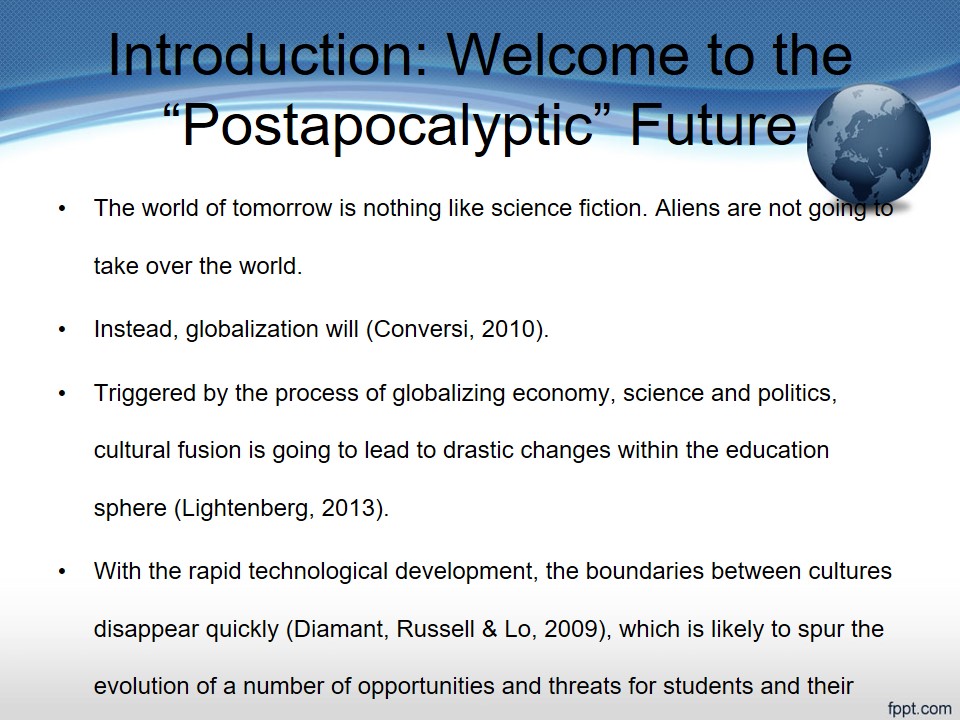
The Threats to Beware
- Inability to communicate messages to the target audience (i.e., students) due to the cultural shock of the latter;
- Choice of the most efficient media to address the issue of cross-cultural communication;
- Conflicts arising due to misunderstandings and misconceptions triggered by differences in cultural/religious/philosophical vision of the world;
- Poor performance of the students due to the absence of specific concepts in the source language/target language (Tuminaro & Redish, n. d.).

Cultural shock as a result of a culture clash
Whenever two or more cultures collide, without a proper preparation, both parties are most likely to suffer cultural shock
A Teacher’s Perspective:
Despite the fact that diversity allows for more opportunities for students, both social and educational (IBM, n. d.), due to specifics of culture, the process of getting used to each other’s traditions is going to take considerable time.
Using Media to Address Cultural Shock
- Using social media and its analysis to introduce the idea of diversity to the students;
- Using visual media to adopt a culturally responsive classroom management approach (Weinstein, Tomlinson-Clarke & currant, 2004, 29);
- Using visual media and footage to introduce the idea of ethnocentrism to the students.
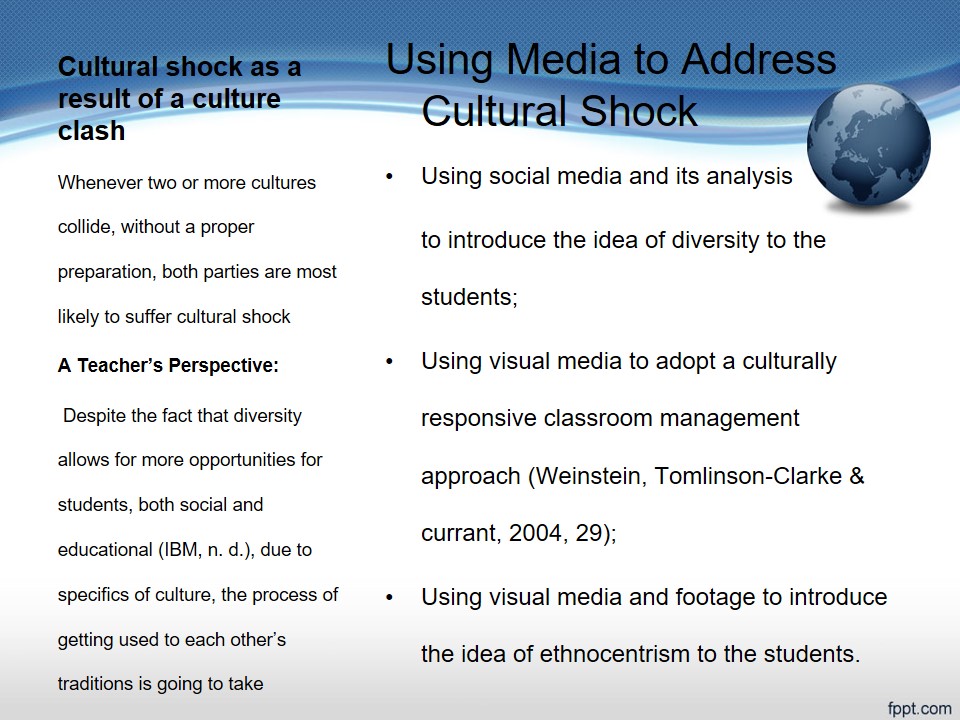
Destruction of cultures due to culture fusion
- Effects of Culture Fusion:
- Significant elements of people’s culture become obliterated;
- Abstract thinking as the most important phase in Piaget’s cycle becomes unreachable;
- As a result, educational process takes much more time and effort and brings less results.
- Means to Address These Effects:
- Adopting the ECN (Education Collaboration network) system (allows for all students to get invested) (Mujist, Wes & Ainscow, 2010).
- Identifying the key differences in the curricula of different state sand come up with a unique blend of these curricula (IBM, n. d., 5).

Destruction of identity and the possible destruction of self
- Loss of the cultural origins;
- Loss of means of cultural identification;
- Inability to realize one’s self;
- Inability to embrace the objective reality;
- Losing touch with the world;
- Destruction of one’s self;
- Loss of an opportunity for a unique opportunity to combine the elements of both cultures.
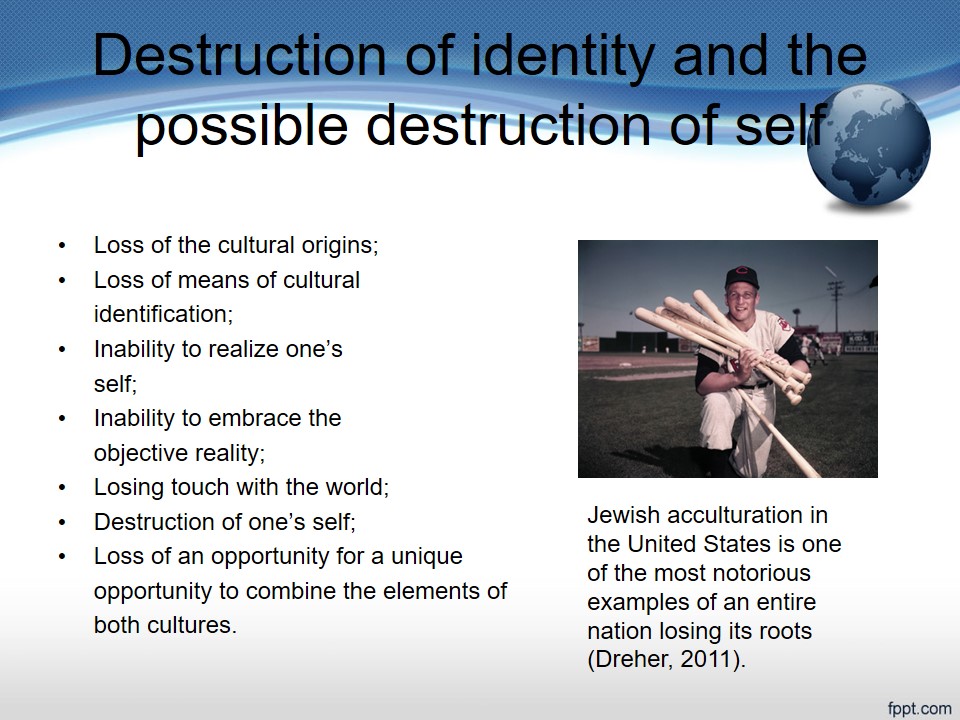
Religious issues: nutritious food for thoughts
- Loss of religious identity following acculturation:
- Loss of national identity;
- Loss of cultural specifics;
- Loss of one’s self;
- Loss of one’s self results in re-establishment of cultural and moral values, religious ideas being among them (Bachaspatimayum, 2011).
- Domination of a single religion:
- Acculturation results in accepting one’s vision of the world;
- Accepting one’s picture of the world leads to acquiring a new life philosophy;
- Acceptance of various nations’ ideas will lead to the creation of a new religion (Eugenio, Pumariega, & Sabagh).
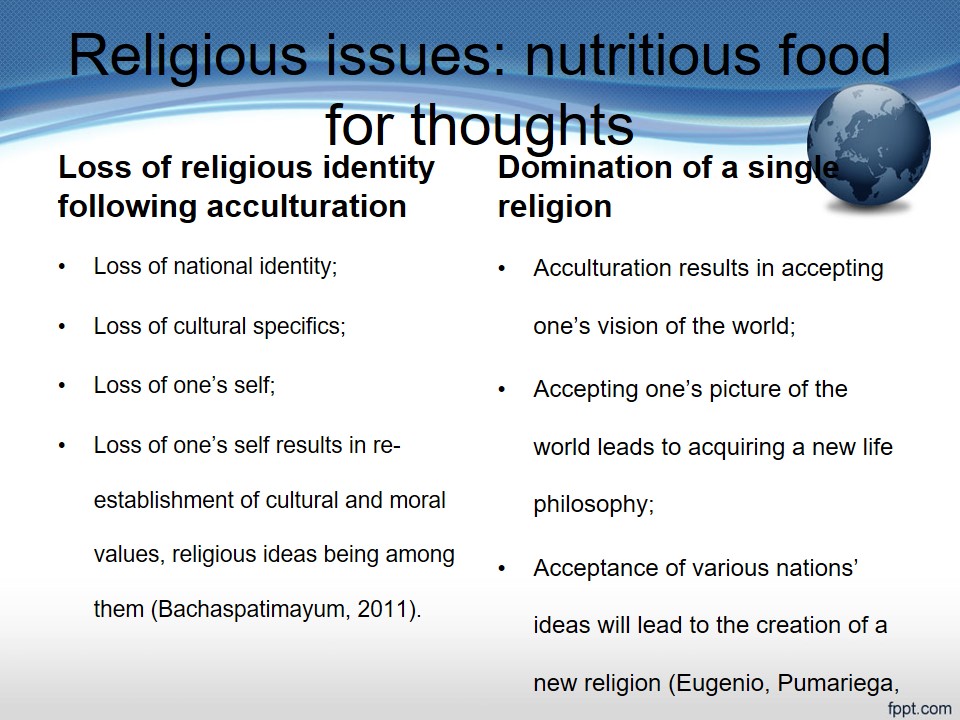
The Opportunities to Chase
Cultural differences are known as the basic reasons for conflicts.
However, specific cultural features can also be used to be able to consider a specific idea from a different point of view.
As a result, cultural fusion allows adopting the capability of looking at a phenomenon/object from different perspectives. In addition, the collision of different cultures presupposes that a fruitful discussion and, therefore, a solution to a specific problem, should be created in the discussion process (Loeb, 2013).
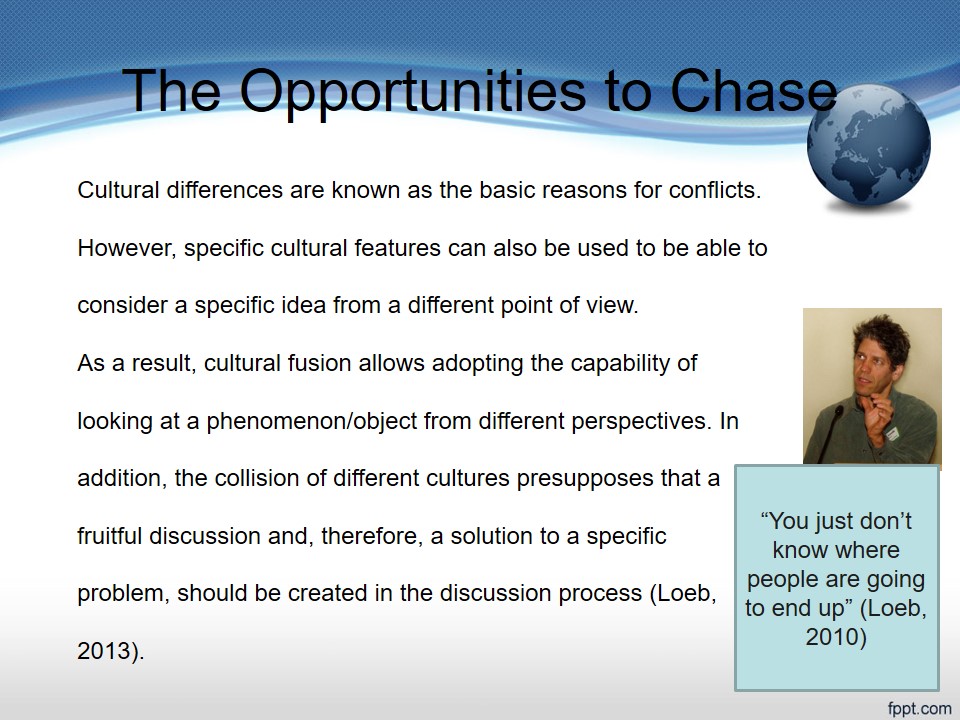
Availability of sources of knowledge
Internet became the place where the answers to the most complicated questions can be fount.
A huge chunk of this information is, however, doubtful.
Advantages:
- Online libraries affordable for immediate use;
- Access to the latest scientific discoveries;
- Ability to upgrade on the latest achievements in the chosen sphere;
- Chance to take part in scientific projects in other states;
- Additional opportunities for ESL learners;
- Flexible schedule.

Improvement of education system
- Current Media and Culture Fusion Related Issues:
- Rapid increase in population number and the following competitiveness in higher education field;
- Increased standards of living in the environment of growing poverty rates;
- Lack of consent about the standards of academic performance in the globalized world.
- Solutions: Technologies and Communication:
- Striving to provide equal opportunities for everyone to create fair competition environment;
- Providing educational opportunities for students from all backgrounds;
- Introducing the idea of a common student performance measurement system (Rumbaut, n. d.).
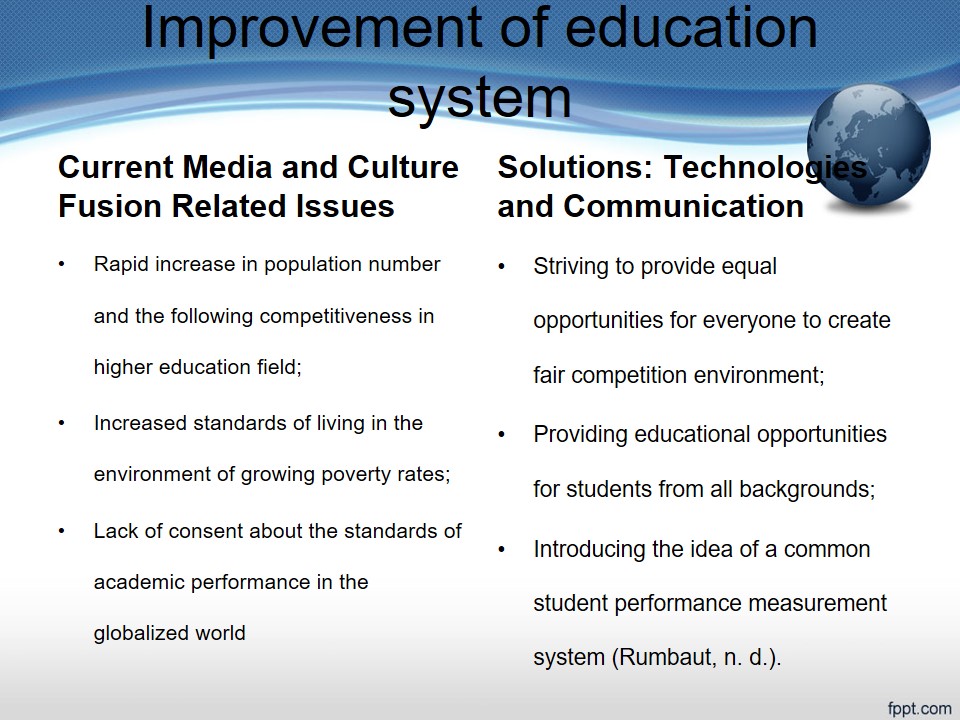
Working on a Solution: In Search for the Golden Mean
- Contributing to cultures fusion without their destruction:
- Helping students retain national traditions while learning about the foreign ones;
- Encouraging students to compare and contrast the elements of their culture with the elements of the local one.
- Using culture fusion process for educational purposes:
- Introduce the students to the idea of cultural/ethnical diversity (Berry, 1997);
- Use modern media (visual and social) to get the key message across;
- Check cross-cultural similarities in concepts for communicating with students more efficiently (Detlaff & Rycraft, 2011).
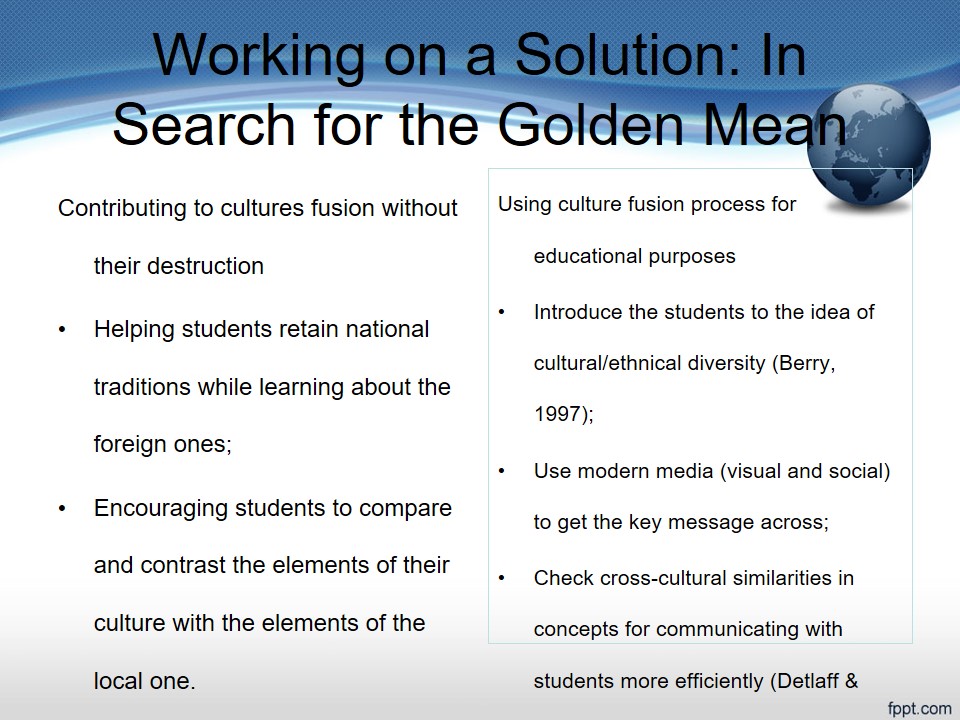
Media as the XXI-century painkiller
The role of media in allowing for retaining cultural values and at the same time providing better integration between different states and different educational systems cannot be overestimated.
- Social networking:
- Despite being a poor substitute for live communication, social networking helps develop communicational skills in students and teachers of other nationalities/ethnicities.
- Blogging:
- Another type of modern media, blogging allows for longer and more thought-provoking conversations, as well as more active discussion of the issue in question.
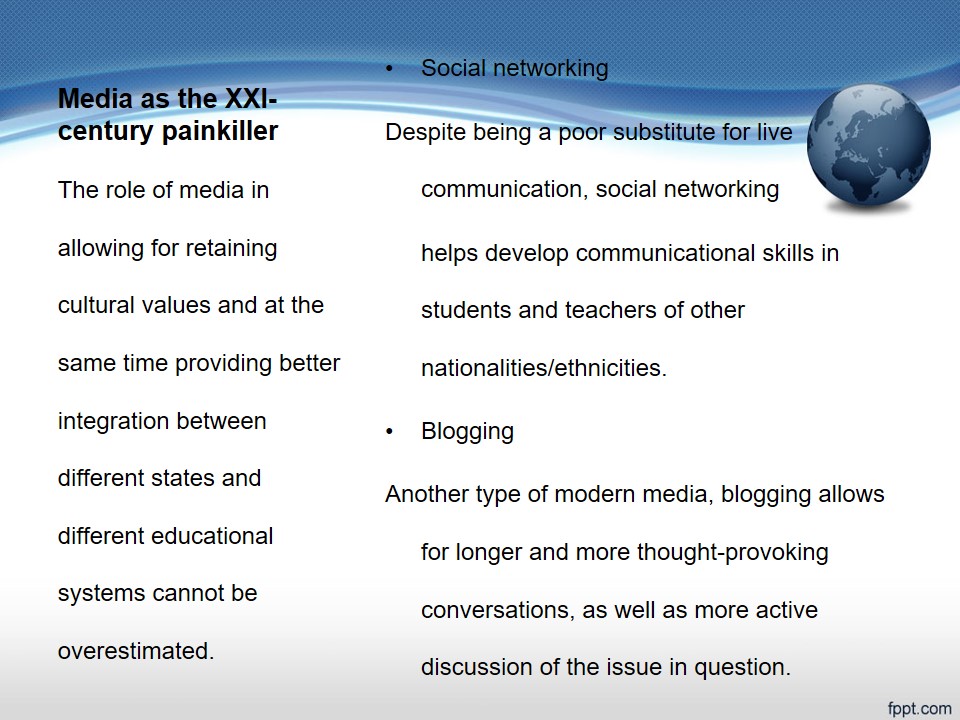
Key issues and the means to address them
- Educational disadvantages:
- Losing the track of the performance of other students;
- Being unable to convey a concept/theory/idea to a student;
- Basic disadvantages:
- Numerous conflicts due to misunderstandings;
- Educational disadvantages solution:
- Developing activities to engage both types of students in;
- Searching for other points of contact between the two cultures;
- Basic disadvantages solution:
- Using conflicts as a means to have a communication experience.

Conclusion: Welcome to a Brand New World
- The clash of cultures is an inevitable outcome of the globalization process and technological development.
- The evolution of mass media is most likely to spur the given process even more.
- The problems associated with the clash of cultures can be avoided, though, by using several strategies.
- Political correctness is a must for an intercultural and intracultural communication.
- Domination of a specific culture must be avoided at all costs.
- By exploring the cultural differences between various ethnicities, one can possibly avoid a number of conflicts.
- Conflicts are an integral and, therefore, crucial part of communication.
- By maintaining the balance between cultural norms, one is able to address the needs of students belonging to different ethnicities.
- Educational process can be spurred by introducing the elements of various cultures into it and, therefore, allowing the students to approach a problem from different points of view.
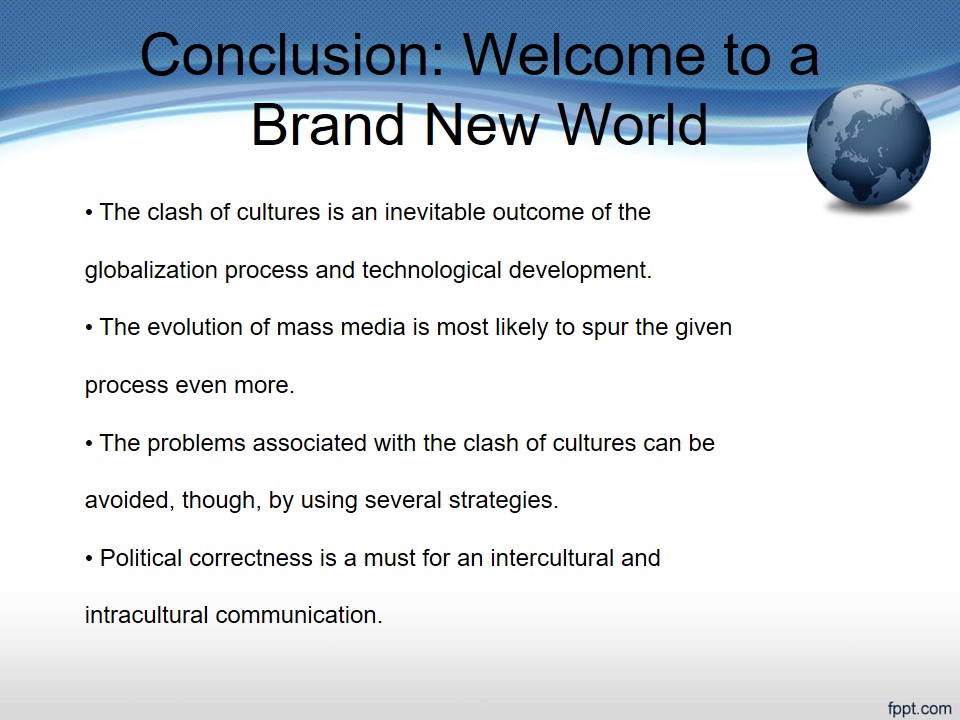
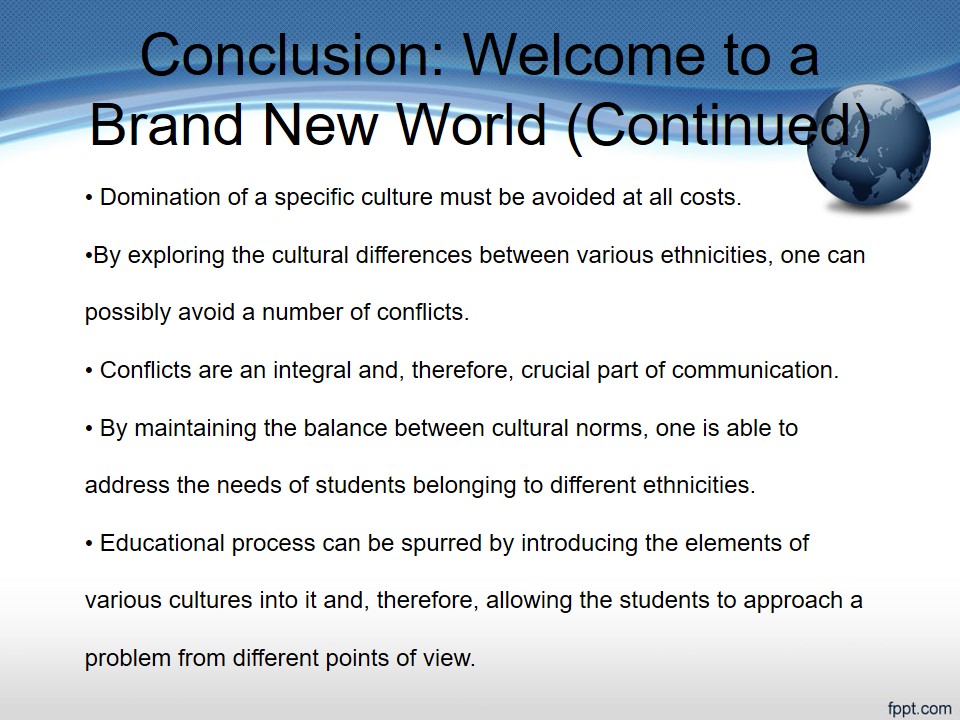
Reference List
Bachaspatimayum, M. (2011). Changes in the religion of the Nepalese of Manipur: Conversion and acculturation. Bodhi: An Interdisciplinary Journal, 5, 2091–6479.
Berry, J. V. (1997) Immigration, acculturation, and adaptation. Applied Psychology: An International Review, 46(1), 5–68.
Conversi, D. (2009). The limits of cultural globalisation? Journal of Critical Globalisation Studies, 3, 36–59.
Detlaff, A. J., & Rycraft, J. R. (2011). The Impact of migration and acculturation on Latino children and families: Implications for child welfare practice. Protecting Children, 21(2), 6–21.
Diamant, E. I., Russell, S. R. & Lo, F.-l. (2009). Collaborating across cultural and technological boundaries: Team culture and information use in a map navigation task. Plato Alto, CA: ACM.
Dreher, R. (2011). Are US Jews assimilating out of existence?The American Conservative. Web.
Eugenio, M. R., Pumariega, M. J., & Sabagh, D. (2011). Identity and acculturation in immigrant and second generation adolescents. Adolescent Psychiatry, 1, 72–81.
IBM (n. d.). Improving India’s education system through information technology. Web.
Inayatullah, B. & Gidley, J. (2000). The University in transformation: global perspectives on the futures of the university. Westport, CT: Bergin and Garvey.
Lightenberg, P. E. (2013). American education: Second to none? How we must change to meet twenty-first century imperatives. Association of American Colleges and Universities, 99(2). Web.
Loeb, P. (2010). Soul of a citizen. YouTube. Web.
Loeb, P. (2013). Soul of a citizen. Web.
Mujist, D., Wes, D. & Ainscow, M. (2010). Why network? Theoretical perspectives on networking. School Effectiveness and School Improvement, 21(1), 5–26.
Rumbaut, R. G. (1997). Acculturation, discrimination, and ethnic identity among children of immigrants. Web.
Tuminaro, J. & Redish, E. (n. d.). Understanding students’ poor performance on mathematical problem solving in physics. Web.